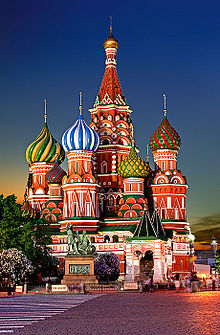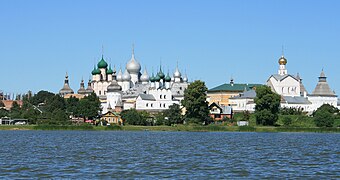Tourism in Russia
This article needs additional citations for verification. (April 2018) |

Tourism in Russia plummeted in 2022. Only 200,100 foreigners visited Russia in 2022, a drop of 96.1% from pre-pandemic/pre-2022 Russian invasion of Ukraine years.[1] Earlier, Russia had seen rapid growth since the late Soviet times, first domestic tourism and then international tourism as well.[2] Russia had formerly been among the most popular tourist destinations in the world, though it fell off that list in 2022. Not including Crimea, the country contains 23 UNESCO World Heritage Sites, while more are on UNESCO's tentative lists.[3]
Tourist routes in Russia include a travel around the Golden Ring of ancient cities, cruises on the rivers including the Volga, and long journeys on the Trans-Siberian Railway. Diverse regions and ethnic cultures of Russia offer different foods and souvenirs, and show a variety of traditions, including Russian Maslenitsa, Tatar Sabantuy, or Siberian shamanist rituals. In 2013, Russia was visited by 33 million tourists, making it the ninth-most visited country in the world and the seventh-most visited in Europe.[4]
History
This section needs expansion. You can help by adding to it. (June 2023) |
After the 2022 Russian invasion of Ukraine, several governments, including the United States, France, the United Kingdom, Australia, and Canada have issued travel advisories calling on their nationals to avoid travel to Russia.[5] For the same reason, airline routes between Russia and Western countries were closed, and supply of spare parts for some domestic airline traffic inside Russia became a challenge.[6]
Only 200,100 foreigners visited Russia in 2022, a drop of 96.1 percent.[1] Most of Europe closed its airspace to Russian planes a few days after Russia invaded Ukraine in February 2022.[1] Foreign-issued Visa and Mastercard cards no longer work in Russia, further impacting tourism.[1]
Cultural tourism


Tourist destinations in Russia include Saint Petersburg (which appeared in the list of top visited cities of Europe in 2010) and Moscow, the current and the former capitals of the country, recognized as World Cities. Moscow and Saint Petersburg museums such as Hermitage and Tretyakov Gallery, theaters including Bolshoi and Mariinsky, churches such as Saint Basil's Cathedral, Cathedral of Christ the Saviour, Saint Isaac's Cathedral and Church of the Savior on Blood, fortifications such as Moscow Kremlin and Peter and Paul Fortress, squares such as Red Square and Palace Square, and streets such as Tverskaya and Nevsky Prospect. Palaces and parks are found in the former imperial residences in the suburbs of Moscow (Kolomenskoye, Tsaritsyno) and Saint Petersburg (Peterhof, Strelna, Oranienbaum, Gatchina, Pavlovsk Palace, Tsarskoye Selo). Moscow contains Soviet-era buildings along with modern skyscrapers, while Saint Petersburg has classical architecture, rivers, channels and bridges.[citation needed]

Nizhny Novgorod is the capital of the Volga region. Nizhny Novgorod is divided into two parts by the Oka River. The Upper City is its historical part. The Lower City is its industrial and commercial part. Here are the Fair, the old Sormovo and Kanavino, GAZ and Sotsgorod (the so-called "city in the city"), the railway terminal, and the airport.[citation needed]
Kazan, the capital of Tatarstan, shows a mix of Christian Russian and Muslim Tatar cultures.[citation needed]
Sakha Republic proposes to use former forced labour camps as a tourist attraction.[7] Poles visit places of Communist crimes, e.g., of the Katyn massacre and Solovetsky Islands.[8][9]
Museums
Russia is home to museums that include the Tretyakov Gallery, the Kremlin Armoury and the State Historical Museum in Moscow, the Hermitage Museum, and the Russian Museum in St Petersburg, the Kazan Kremlin in Kazan, etc.[citation needed] Russia has museums related to its literary and classical music heritage, such as Yasnaya Polyana associated with Leo Tolstoy, the Mikhaylovskoye Museum Reserve associated with Alexander Pushkin, the Dostoyevsky Museum, the Tchaikovsky State House-Museum, and the Rimsky-Korsakov Apartment and Museum.[citation needed]
Museums related to Russia's military history and military hardware include the Central Museum of the Great Patriotic War on Poklonnaya Hill, the Central Naval Museum in St Petersburg, the Battle of Stalingrad Museum in Volgograd.[citation needed] Museums related to science and technology include the Polytechnic Museum of Moscow, and the Memorial Museum of Cosmonautics.
The GULAG History Museum tells the story about the GULAG camps in Siberia.[10]
Nature tourism
In Russia, Nature Reserves have history and it has its own word of definition Zapovedniks (Template:Lang-ru, plural заповедники, ) more than 100 Nature Reserves exist in Russia and more than 50 National Parks. National parks and sanctuaries of Russia include the Baikal Nature Reserve , the Altai Nature Reserve, the Lazovsky Nature Reserve, the Kedrovaya Pad Nature Reserve, the Curonian Spit National Park, the Valdaysky National Park, the Baikal-Lena Nature Reserve, the Ilmen Nature Reserve. The Seven Wonders of Russia include Lake Baikal, Valley of Geysers, Manpupuner rock formations, and Mount Elbrus. Other areas include Republic of Adygea where Fisht Mountain is located, Chechnya Republic where Lake Kezenoyam is located.[11]
Health tourism

Mineral spa resorts have been established across Russia in such regions as Kamchatka Krai, Altai Krai, Krasnodar Krai, Stavropol Krai, North Caucasus region of Russia.[12] Some cites have natural hot spring water during winter and some of Russian cities are called Russian Spa town, including Pyatigorsk, Yessentuki, Kislovodsk, Zheleznovodsk and Mineralnye Vody; these towns are jointly known as the Caucasian Mineral Waters.
Russia has one of the largest water borders in world, but only the more Southern regions are suitable for resort tourism. The warm subtropical Black Sea coast of Russia is the site for some seaside resorts such as Sochi and Tuapse.[citation needed]
Winter sport
A vast part of Russian territory is in Subarctic climate and humid continental climate, and that is why it is cold. In addition, Russia is mountainous in regions like Northern Caucasus, Altai Krai and Kamchatka Peninsula. The Highest peak in Europe, Mount Elbrus, is in Russia, which makes Russia a place for Winter sport. Ski resorts are in Russia. A ski resort in Russia is Sochi and its Krasnaya Polyana. Other ski resorts in Russia are Dombay in Karachay–Cherkessia in Northern Caucasus.[citation needed]
Medical tourism
Russia is a destination for medical tourism. A factor in its popularity was the relatively weak ruble post-2014, which saw the industry grow from some 110 thousand clients in 2017[13] to some 728 thousand clients in the first five months of 2020.[14] Stomatology is the most used (44% of patients), genecology and urology follow (25% taken together), the other services are plastic surgery (10%), ophthalmology (10%), and cardiology (5%).[13] Most clients come from the CIS states, where receiving high-tech medical assistance can be problematic, particularly from Central Asia, which amounts for 62% of all patients; but also from Eastern Europe (32%), South and East Asia (5%).[15] In addition to price and accessibility of complex manipulations, the difference in regulations between Russia and the clients' own nations is a driving factor for receiving care in Russia: for instance, in vitro fertilization is illegal in China, but legal in Russia.[14]
Religious tourism
Religious tourism has two main subtypes: pilgrimage, as travel done for religious or spiritual purposes, and the viewing of religious monuments and artefacts, as a kind of sightseeing. The former is relatively insignificant for the Russian tourism industry, amounting for approximately 100 thousands pilgrims yearly.[16] The latter is more important.[citation needed] Orthodox Christianity being the most common religion in Russia, it also accounts for most religious monuments across the country.[citation needed]
-
Domes of Sobornaya Square in Moscow Kremlin
-
The Valaam Monastery
Multiple pieces of Islamic religious architectural art are scattered across the country, from mosques to maqāms. They are mostly clustered in the historically Muslim regions.[citation needed]
-
The Kul Sharif Mosque in Kazan
-
Lala Tulpan in Ufa
-
The Juma Mosque in Derbent built 736
Russia has a Buddhist minority.[citation needed]
-
The Datsan Gunzechoinei in St.Petersburg
-
The Burkhan Bakshin Altan Sume in Elista
-
Ivolginsky Datsan in Buryatia
Foreign travel statistics
In 2013, 27 million international tourists arrived in Russia, generating US$11.2 billion in international tourism revenue for the country.[17][failed verification] Including domestic and international tourism, the industry directly contributed RUB860 billion to the Russian GDP and supported 966,500 jobs in the country.[18]
However, only 200,100 foreigners visited Russia in 2022, a drop of 96.1 percent.[1]
See also
- Visa policy of Russia
- Russian culture
- List of museums in Russia
- List of World Heritage Sites in Russia
- Wildlife of Russia
References
- ^ a b c d e "Tourism collapses in Russia following western sanctions". Al Arabiya English. 9 February 2023.
- ^ "Number of inbound tourism visits to Russia from 2014 to 2022", Statista, 27 April 2023
- ^ "UNESCO World Heritage Centre – Tentative Lists". UNESCO. Retrieved 16 December 2017.
- ^ "Tourism Highlights 2014" (PDF). E-unwto.org. Archived from the original (PDF) on 12 January 2015. Retrieved 16 December 2017.
- ^ "Europe: Russia extends flight suspension at multiple southern and central airports until April 19 /update 40". Europe: Russia extends flight suspension at multiple southern and central airports until April 19 /update 40 | Crisis24.
- ^ "Sanctions: Russia's commercial airlines face a slow death", Deutsche Welle, 18 November 2022
- ^ Luhn, Alec (26 March 2014). "Russia's Sakha Republic proposes 'tourist camps' on former gulag sites". The Guardian.
- ^ "Strona domeny katyn.pl". Katyn.pl. Archived from the original on 14 April 2016. Retrieved 16 December 2017.
- ^ Itaka, Biuro Podróży. "Tajemnice Wysp Sołowieckich – ITAKA". Itaka.pl. Retrieved 16 December 2017.
- ^ "GULAG History Museum". gmig.ru.
- ^ "40 most beautiful places in Russia". Russianblogger.me. Retrieved 30 September 2015.
- ^ "Hit the spa Russian style: Mineral springs and hot tub substitutes". 2 March 2016.
- ^ a b "Медицинский туризм: почему иностранцы лечатся в России, а россияне — за границей" [Medical tourism: why foreigners seek treatment in Russia, and Russians abroad]. forbes.ru (in Russian). 14 August 2018. Retrieved 15 August 2021.
- ^ a b "Какое лечение в России выбирают иностранцы" [What kind of medical treatment do foreigners choose in Russia]. ratanews.ru (in Russian). RATA news. Retrieved 15 August 2021.
- ^ Daykhes, Arkady N.; Jakovljevic, Mihajlo; Reshetnikov, Vladimir A.; Kozlov, Vasily V. (2020). "Promises and Hurdles of Medical Tourism Development in the Russian Federation". Frontiers in Psychology. 11: 1380. doi:10.3389/fpsyg.2020.01380. PMC 7324547. PMID 32655455.
- ^ "Туристов отделят от паломников с 1 ноября" [Starting November 1, tourists will be separated from pilgrims]. atorus.ru (in Russian). Ассоциация Туроператоров. 23 July 2019. Retrieved 15 August 2021.
- ^ "Tourism Highlights 2013 edition" (PDF). Dtxtq4w60xqpw.cloudfront.net. Archived from the original (PDF) on 27 November 2013. Retrieved 27 November 2013.
- ^ "2013 Travel & Tourism Economic Impact Report Russian Federation" (PDF). Wttc.org. Archived from the original (PDF) on 2 December 2013. Retrieved 27 November 2013.
External links
- Moscow City Guide at the official website of the Mayor of Moscow
- St Petersburg Official City Guide
- Karelia Tourist Portal (Solovetsky Islands, Kizhi)
- Guide to the Golden Ring of Russia
- Tatarstan Official Guide(including Kazan)
- Official Rosa Khutor Guide (ski resorts in Sochi)
- Baikal Tourist Guide
- Vladivostok City Guide
- Template:Curlie
- (in Russian) Federal Agency for Tourism
- Cheboksary tourist portal Archived 13 August 2018 at the Wayback Machine
































